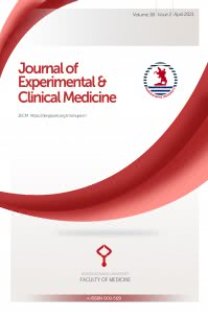Kalsiyum glukonat, potasyum klorür ve sodyum bikarbonat'ın insan eritrosit glukoz 6-fosfat dehidrogenaz enzimi üzerine in vitro etkileri
Eritrositler, Glukozfosfat dehidrogenaz, Potasyum klorür, Sodyum bikarbonat, Kalsiyum glukonat
In vitro effects of calcium gluconate, potassium chloride and sodium bicarbonate on human erythrocyte glucose 6-phosphate dehydrogenase
Erythrocytes, Glucosephosphate Dehydrogenase, Potassium Chloride, Sodium Bicarbonate, Calcium Gluconate,
___
1. Sodeman WA Jr, Sodeman TM. Sodeman's pathologic physiology mechanism of disease, 1985. Çev: kurul, Fizyopatoloji cilt 2. Ankara, Türkiye Klinikleri Yayınevi, 1991: 720-724. 2. Litz CE, Me Clure JS, Burning RD. Blood and bone marrow. In: Damjanov I, Under J (eds). Anderson's pathology. Missouri, Mosby-Year Book Inc, 1996; 1063-1114. 3. Weksler BB, Moore A, Tepler J. Hematology. In: Andreoli TE, Carpenter CCJ, Plum F, Smith LH Jr (eds). Cecil essentials of medicine. USA, WB Saunders Co., 1990; 342-403. 4. Fairbanks VF, Klee GG. Biochemical aspects of hematology. In: Burtis CA, Ashwood ER (eds). Tietz textbook of clinical chemistry. USA, WB Saunders Co., 1994; 1974-1979. 5. Telefoncu A, Telefoncu F. Glukoz-6-fosfat dehidro- genaz akfivitesine primaquine'nin etkisi. Tr J Medical Sci 1989: 14: 57-63. 6. Berkow R (Editor-in-Chief). The merck manuel, 1992. Çeviri ed: Keklikoğlu M, Tuzcu M. Tanı/ tedavi el kitabı. İstanbul, Nobel Tip Kitabevleri ltd., 1995; 1136-1174. 7. Andrews MM, Mooııey KH. Alterations in hematologic function in children. In: Me Cance KL, Hu ether SE eds. Pathophysiology. Missouri, Mosby-Year Book Inc 1994; 908-942 8. Kayaalp SO. Rasyonel yedavi yönünden tıbbi farmakoloji. Ankara, Feryal Matbaacılık 1998; 153-154. 9. Beuller E. G6PD deficiency. Blood 1994 81:3613-3636. 10. Rang HP, Dale MM, Ritter JM. Pharmacology China. Chürchil Livingstone 1999: 746-756. 11. Shreve DS, Levy HR: On the molecular weight o human glucose-6-phosphate dehydrogenase Biochem Biophys Res Com 1977; 78: 1369-1375. 12. Çiftçi M, Küfrevioğlu Öİ, Gündoğdu M, et al. Effect, of some antibiotics on enzyme activity c glucose-6-phosphate dehydrogenase from humai erythrocytes. Pharmacol Res 2000: 41: 109-113. 13. Ninfali P, Orsenigo T. Barociani L, et al. Rapiı purification of glucose-6-phosphate dehydrogenas from mammal's erythrocyte. Prep Biochem 199C 20: 297-309. 14. Delgado C, Tejedor C, Luquue J. Partial puriiicatio of glucose-6-phosphate dehydrogenase from n: eıythrocyte haenıolysate by partitioning in aqueou two-phase system. J Chromatogr 1990; 49c: 159-168. 15. Morelli A, Benatti U, Gaetani GF, et al. Biochemic; mechanisms of glucose-6-phosphate dehydrogenas deficiency. Proc Natl Acad Sci 1978; 75: 1979-198c 16. Laemmli DK: Clevage of structural proteins durii in assembly of the head of bacteriophage T4. Nairn 1970; 227: 680-83. 17. Beutler E: Red cell metabolism manuel _____ biochemical methods. London, Academic Pres 1971. 18. Tang TK. Free radical theory of erythrocyte aging. Formos Med Assoc 1997; 96(10): 779-783.19. Tsai KJ, Shih LY, Hung SW, el al. Enhaııcı vesiculation exacerbates complement-depend e: hemolysis in glucose-6-phosphate dehydrogena: deficient red blood cells. Life Sci 1996; 59: 867-871 20. Devi CV, Anandaraj MP. Calcium activated neutr protease & calcium ATPase in glucose-6-phospha dehydrogenase deficiency hemizygotes. Indian Med Res 1995; 101: 39-41. 21. Dememle G, Guida L, Sdraffa A. et al. Mechanisı of perturbation of eıythrocyte calcium homeostaf in lavism. Ceel Calcium 1992; 13: 649-658.
- ISSN: 1300-2996
- Yayın Aralığı: Yılda 4 Sayı
- Başlangıç: 2018
Şizofrenide risperidon ile olanzapinin karşılaştırılması
Gaziantep il merkezindeki gebe kadınlarda A vitamin ve B-karoten düzeyleri
Şahin KILINÇER, İclal MERAM, Ali İhsan BOZKURT
Sayit ALTIKAT, Mehmet Emin BÜYÜKOKUROĞLU, Mehemt ÇİFTÇİ, Nuri BAKAN, ÖMER İRFAN KÜFREVİOĞLU
Çocukluk çağı kanser hastalarının epidemiyolojik incelenmesi
Nilgün ÖZBEK, Şaban ÇAKIR, Baki TARAKÇI, Melek COŞKUN
The acanthosis nigricans associated with gastric adenocarcinoma and neurofibromatosis
Tayyar CANTÜRK, Levent YILDIZ, Asiye YILDIZ, Oğuz AYDIN, Ahmet Yaşar TURANLI
Zahide DOĞANAY, Fikret BİLDİK, Dursun AYGÜN, Hakan GÜVEN, Levent ALTINTOP, Murat YERLİYURT
SEZGİN GÜNEŞ, Hasan BAĞCI, NURTEN KARA
Multipl sklerozda human lökosit antijen sıklığının incelenmesi
Hüseyin ATEŞ, Gülten TUNALI, Belma DURUPINAR
